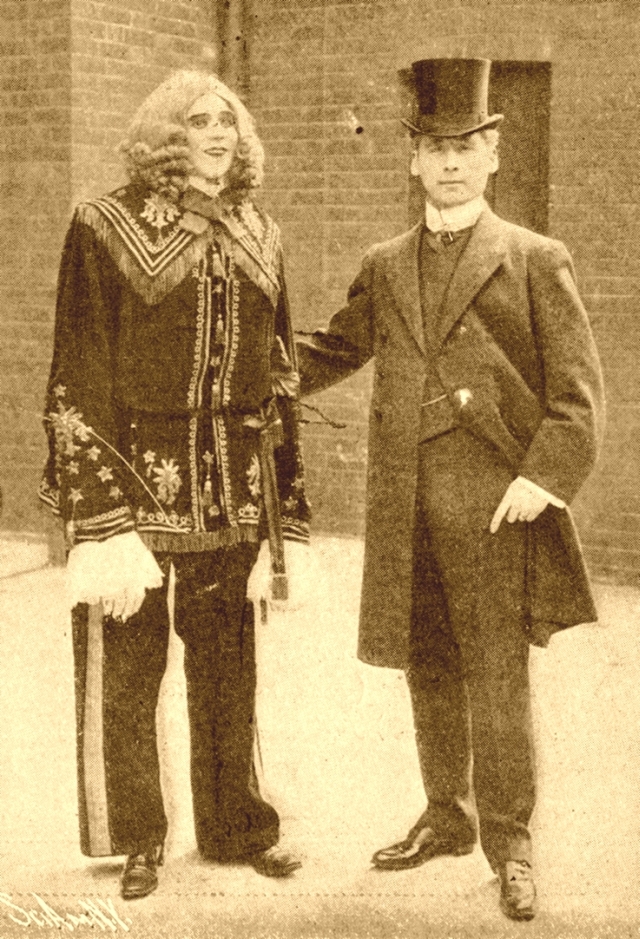
(Images from Scientific American article Jan 13, 1906)
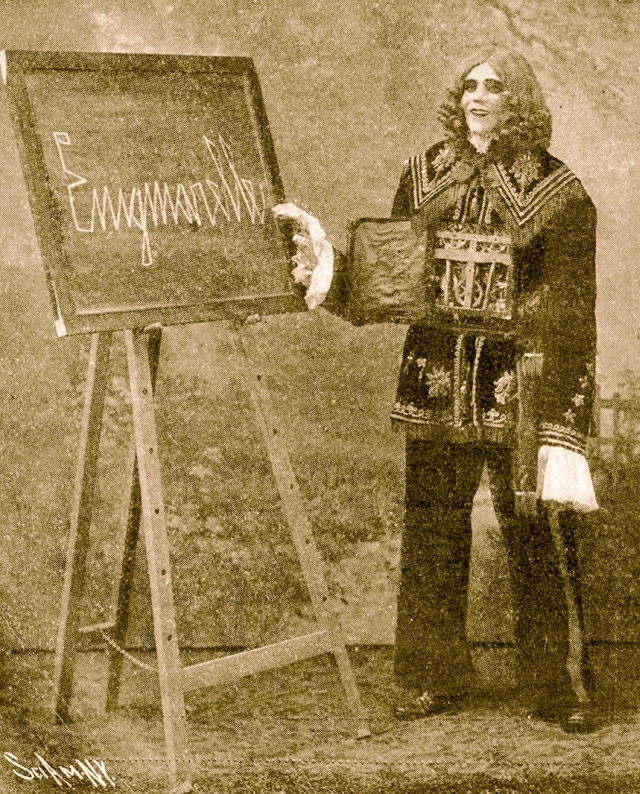
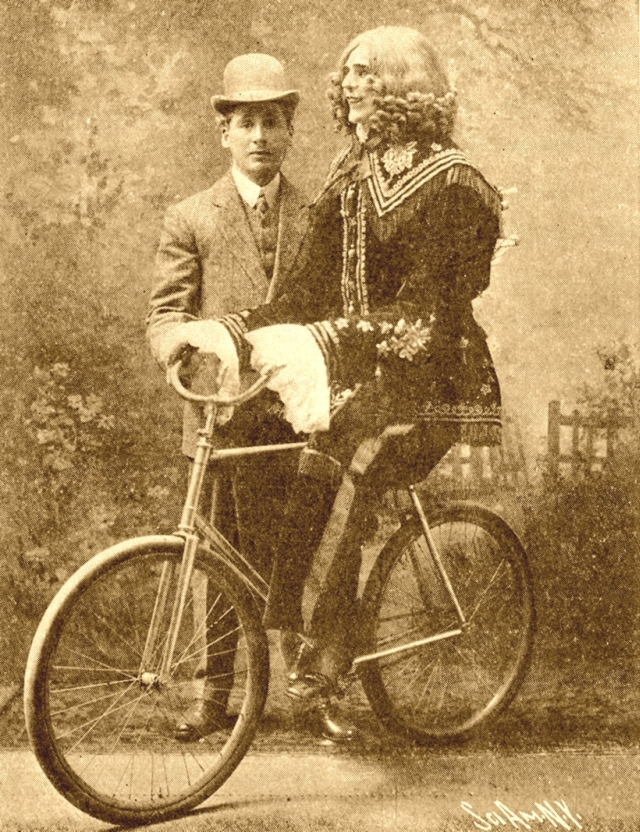
January 13, 1906 edition of Scientific American.
A CLEVER MECHANICAL AND ELECTRICAL AUTOMATON.
An interesting, novel, and pseudo-scientific attraction has recently been entertaining London audiences at the Hippodrome variety theater. This is a cleverly-constructed figure which apparently walks and writes automatically. It is called Enigmarelle," and is seemingly a mechanical and electrical combination. The figure stands exactly six feet in height, weighs 198 pounds, and is composed of 365 distinct and separate parts. As to composition, the feet are of iron, the lower limbs of steel and wood, while the arms are of steel and copper. The body is an insulated steel wire frame, cased with fiber and rawhide, while the head is of wax. The figure contains seven motors, three of which are spring and four electric. They are distributed in different parts of the body and are said to operate the various members assigned to them in the following manner:
The two most powerful motors, which are of special design, propel the lower limbs, and cause the automaton to walk. A third operates the arms, a fourth the balance weights. Of the spring motors, the first controls the head, the second acts as an auxiliary to the electric motors In the movement of the arms, while the third operates the wire bobbins, which wind and unwind with the ever-changing position of the weights. There are fourteen dry storage battery cells of small capacity. They are of special design and constructed to serve a double purpose—not only to furnish power to the motors. but also to maintain the equilibrium of the figure. A little below where the hip joint would be on the left of the figure, is the terminal of a semi-circular vulcanite track, which passes up and over the upper part of the chest, descending and terminating on the right side at a level with the terminal on the left. Upon this track travel fourteen ballbearing swinging carriages, their movements being controlled by an electric motor. The carriages are filled with dry storage batteries, the combined weight of which is sixty pounds. These batteries are shifted from one side to the other of the body by means of an electric motor controlled by a mercury governor.
At the back of the figure is the switchboard containing the rheostat, fifteen switches, three single levers, and three automatic brakes, besides several other ingenious devices for directing the movements.
The connections are made, the current switched on, and at a given number of degrees or steps regulated by the centered gear-wheel, working on the cam of the motors, the weights are released from their normal cantor and rapidly descend into the abdominal cavity on the right, causing the figure to lean forward at an angle of 20 degrees. The motor controlling the left limb being in full operation throws its member forward, the figure being in such a position that this free and rapid movement swings it round to the right; at the same instant the mercury governor, finding its level, forms an electric contact setting in motion the motor which rapidly draws the weights back to the line of gravity and causes the figure to regain its equilibrium. By changing the gear wheel, which controls the number of steps, the distance traversed is increased or decreased.
The figure also writes its name, "Enigmarelle," upon at blackboard. The arrangement by which this is done is said to be a series of electromagnets in the shoulder. These attract an armature in the upper arm and cause the latter to make certain strokes.
The method by which the crowning feat, that of riding a cycle, is accomplished is similar to the walk. At a given number of revolutions the weights again descend into the abdominal cavity. but in this instance on the left, causing the cycle and figure, which are attached, to lean toward the center, at an angle of about 40 deg. with the perpendicular, so that the figure, like a coin or wheel, starts round a circle. The arm locks the handle bar at an angle such that the bicycle will turn the circle desired and the feet revolve the pedals and drive the machine in the regulation manner.
[The photographs of this automaton were submitted to the managers of a well-known New York theatrical enterprise and they at once stated that they had seen the automaton in London and that there was really a man concealed in the midst of this aggregation of machinery. -Ed.]
[19 Apr 2011 – Thanks to David (see comments below) who supplied a copy of this article. A seemingly convincing article from a reputable magazine, but published with caution.]
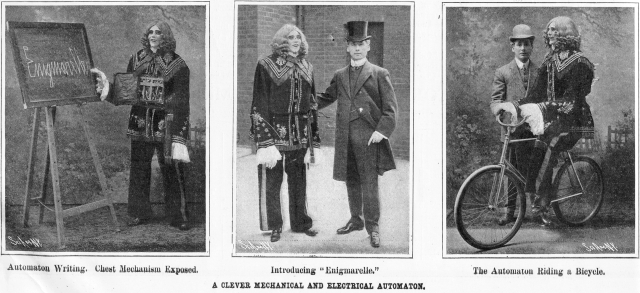
From Ord-Hume's Clockwork Music
Another and equally specutacular 'android' was that exhibited at the London Hippodrome in 1905. Called Enigmarelle, this seven-foot high figure possessed incredible abilities. It would walk on to the stage, write its name in somewhat backward-sloping manuscript upon a blackboard, and then ride a bicycle in a circle. Its head was of wax, its feet of steel and its legs of wood and iron. The motive power comprised no less than seven motors-three being spring, and four electric which drew their power from wet-cell batteries concealed in the trunk. Unbuttoning its waistcoat revealed a mass of wheelwork and wires, levers, and cranks. Unfortunately, within all this trumpery there beat no mechanical heart, but that of a real, live man.
Most of this post consist of copies of existing articles on the net. I've included a few images that may add to the story. Vitaphone has (or used to) a large blog on Enigmarelle, as has Museumofhoaxes. The Alba Root info came from here – http://monsterkidclassichorrorforum.yuku.com/topic/25847 .
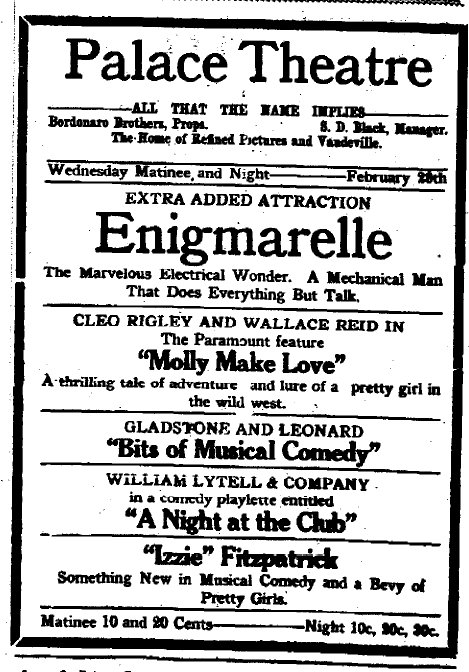
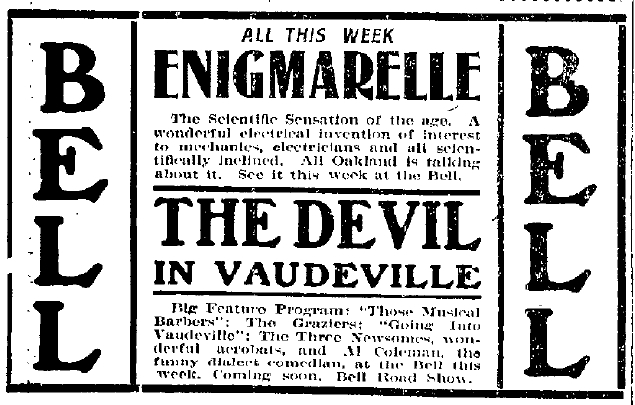
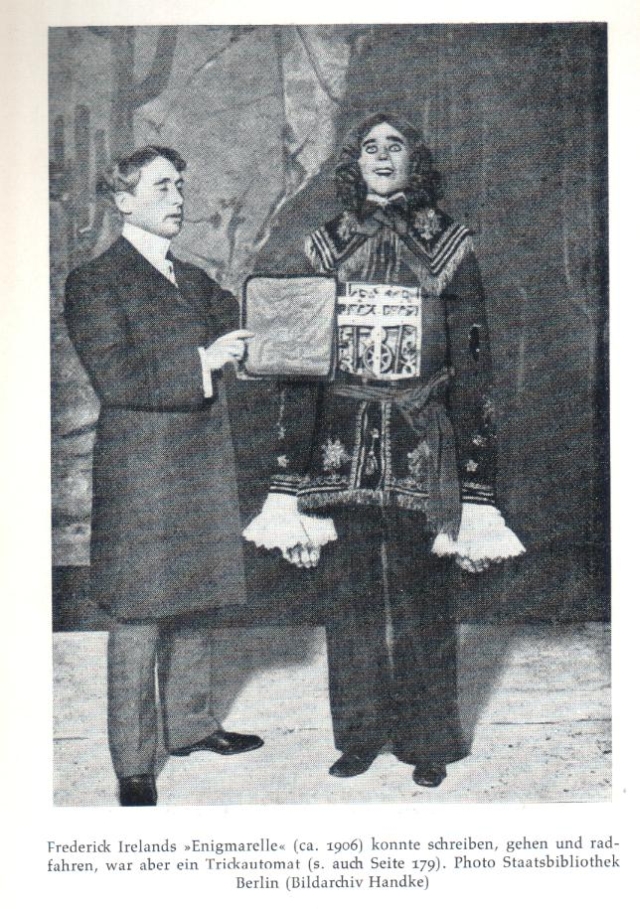

From this link: http://www.museumofhoaxes.com/hoax/forums/viewthread/5637/
According to my family research, Enigmarelle was actually my great great grandfather. He lost both legs in a train accident as a boy and worked Vaudeville shows riding a unicycle with artificial legs. Supposedly, he was also Enigmarelle and wore a fake head and suit. When people doubted the fact that he was a “robot”, he would show them the fact that he had no legs. My grandmother remembers seeing the creepy head in her attic as a child.
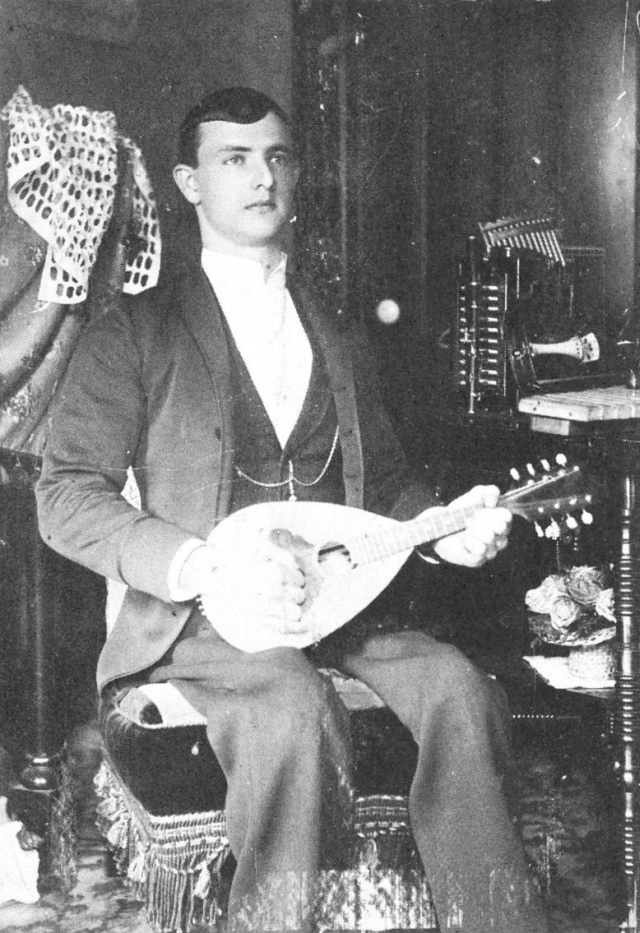
Above: Is this Alba Root before he transformed into Enigmarelle? His legs look as if they are artificial and he has the same characteristic hands.
I [museumofhoaxes] had found this blog post http://vitaphone.blogspot.com/2007/04/enigmarelle-co.html [link currently broken} last night and sent it along to some family. Some more information is coming in, but one relative responded:
“I had heard (through the “grapevine”) that Enigmarelle was a female- with a long skirt or dress, and that that is where G-G-pa would operate the doll from- down inside it by removing his prosthetic legs. I had heard that they would remove her “top half” to show that it was “magic””
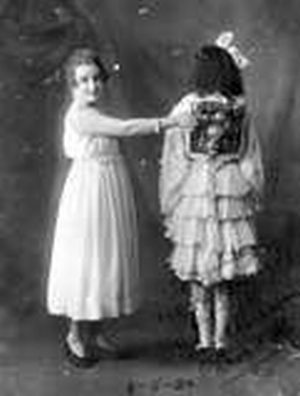
Is this the female Enigmarelle being referred to in the above forum article?
Enigmarelle was actually Alba Root, my great great grandfather. I have some contracts from the Colonial Theater in Lawrence, Mass, the B.F Keith Theaters in Providence and Pawtucket, and A.M. Bruggemann’s Amusement Enterprises in Hoboken from 1905-1907. At that time “Enigmarelle” was making $250/week—very good money I would think. I have a 1 cent post card which says “The Incomprehensible Mystery…….Enigmarelle? Kelley and Root, equal Sole Owners. Think it over!”
I also have a contract from Moss’ Empires, Limited with a Mr Frederick Ireland, manager for Enigmarelle to play at the Hippodrome in London in 1905.
I have no information about Kelley—so if anyone out there does, please send it on to me.
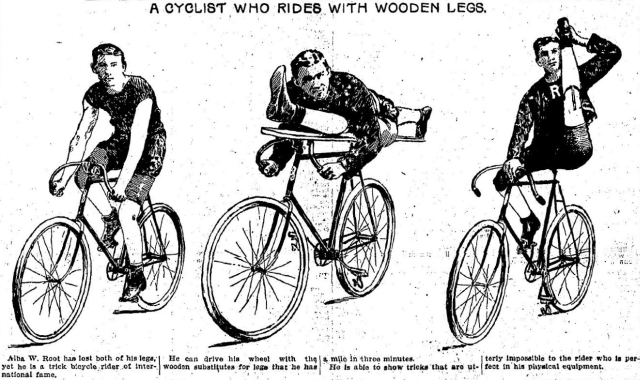
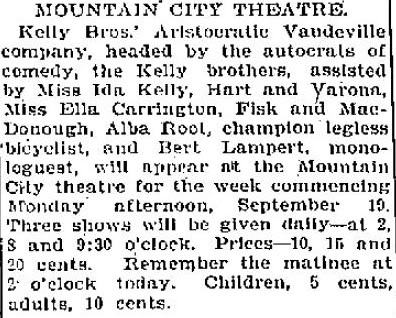
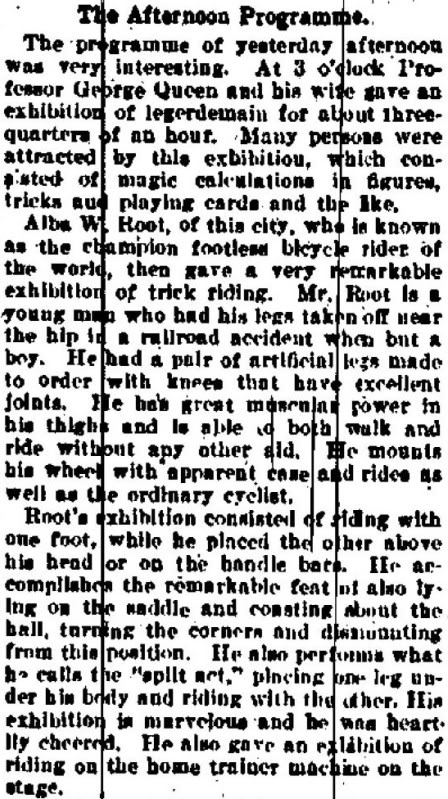
http://monsterkidclassichorrorforum.yuku.com/topic/25847/t/Solving–LONDON–MIDNIGHT-mystery–
featuring-Lugosi-Karloff.html?page=1
—
There seems to be little doubt that Enigmarelle indeed played London in 1905. The full British version of the OED notes under its entry for automaton: "1905. Enigmarelle was the first robot called an automaton exhibited in London." Additionally, the catalogue of British film company Charles Urban Trading Co. for 1905 includes a 125ft variety film titled ENIGMARELLE THE WONDERFUL AUTOMATON [short citwf entry here].I suspect Enigmarelle played elsewhere in Europe as well, since the 1908 edition of the long-running and popular German annual aimed at children, Das neue Universum, apparently includes a two-page piece titled 'Der Automat Enigmarelle.'
One intriguing thing noted in the 'comments' at the bottom of the Vitaphone Varieties blog entry is that Enigmarelle supposedly appeared as late as January 1938 on the invitation card to the Exposition internationale du surréalisme in Paris (an exhibition dedicated to the theme of 'bluffs and illusions'). The card is pictured in Annabelle Görgen's recent German-language book on the significance of the exhibition, and there's a small reproduction of it at this link:
http://www.verlag-silke-schreiber.de/alles_andere/074_goergen.htmlThe card refers to Enigmarelle, seen among several uniformed men, as 'a veritable descendant of Frankenstein', and a piece in the French daily Le figaro (16th Jan. 1938, p.2) leaves little doubt that this was one and the same Enigmarelle:
'le clou sera l'automate Enigmarelle, construit en 1900 par l'ingénieur américain Ireland, et que l'on pourra voir en fausse chair et en faux os traverser à minuit et demi l'exposition.'
('the showstopper will be the automaton Enigmarelle, constructed in 1900 by the American engineer Ireland, which one will be able to see 'in the (false) flesh' as it traverses through the exhibition at half-past midnight'.)However, although a crowd apparently turned up to see Enigmarelle, he proved a no-show, with dancer Hélène Vanel filling in while everyone waited for him to appear, only to be disappointed.
[one online account of this, albeit in French]. An enigma indeed!
Hi David, Yes, I would be interested in a full copy of the article. Thanks very much for the offer. Cheers, Reuben.
I have the Scientific American article concerning Enigmarelle, published in January,1906.
If you wish me to email the complete article,
just let me know and I would be pleased to do so.